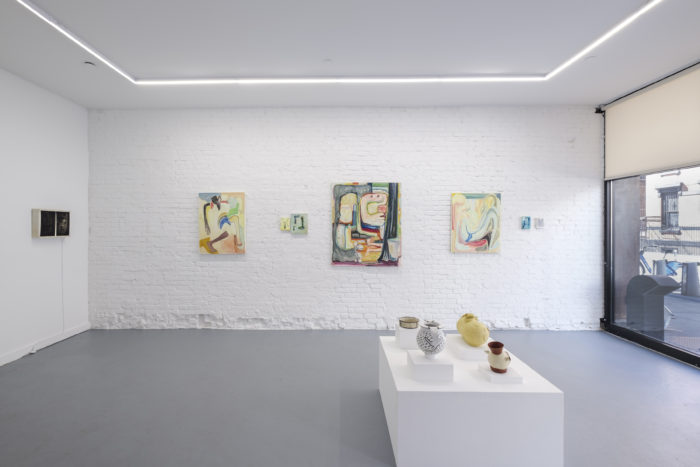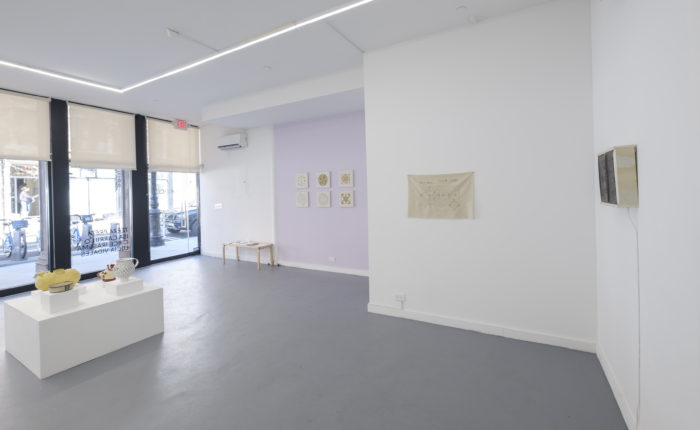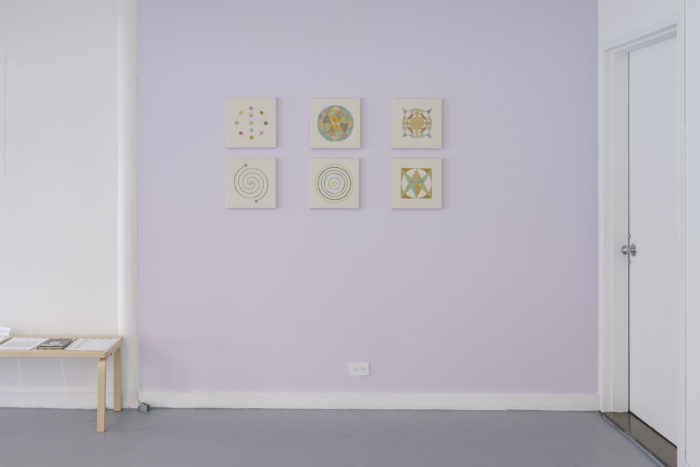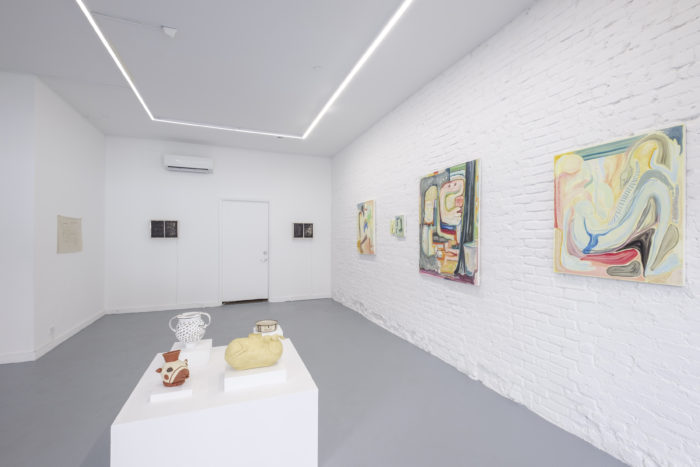
The three-artists show that comprises “Terra Preta” at PROXYCO, a small gallery on Suffolk Street just south of Houston, addresses the theme of “dark earth,” the English translation of the show’s title. The Mexican women artists in the exhibition–Isa Carrillo, Circe Irasema, and Lucía Vidales–address the fertility of black soil through images that tend to illustrate the mythologies of the South American geography in which this kind of soil exists. Carillo offers embroidery, usually circular in its imagery, that is abstract but symbolic of inner unity, while Irasema presents a small group of papier-mâché sculptures that look very much like everyday containers–exquisitely made, but which actually refer to objects from much earlier times. Lucía Vidales makes semi-abstract, semi-figurative paintings of oil, sometimes mixed with encaustic or acrylic, that demonstrate well an eye for visual cohesiveness and painterly emotion. While these works, curated by Paulina Ascencio, do not openly address the theme of darkened earth, they do generally reflect a sense of artistic unity in cultural terms–ways of presenting insight that relates to Hispanic realities that are not fully addressed in the New York art world.
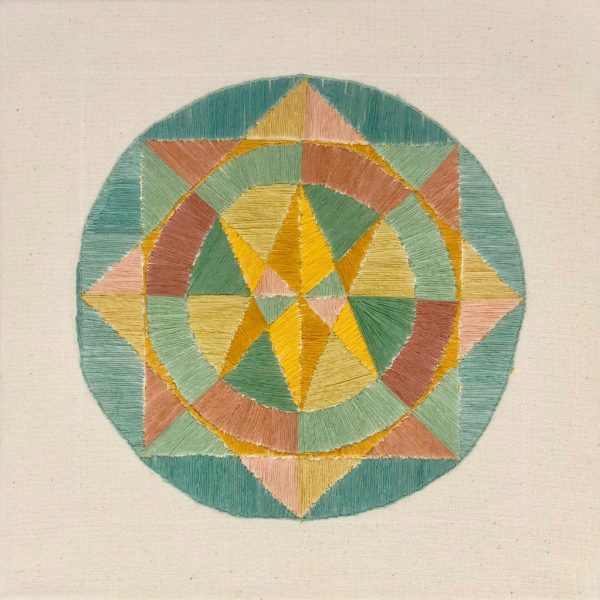
Carrillo’s embroidered imagery shows a strong affinity with geometric design. The work is not as simple as it seems at first. For example, Hidden Messages 2 (2019), 12 inches square, consists of a circle containing a square containing a circle, inside of which are geometric forms–triangles of different colors: green, blue, yellow. The title itself indicates that the image’s theme is occult, while using thread to achieve the image conveys a homely directness we do not usually find in contemporary art, although the method may suggest, indirectly, a feminine (or feminist) assertion. But the real point of this work and the others, which are fairly similar in their overall gestalt, feels like an assertion of visionary insistence in regard to the designs and patterns of ancient cultures. There is no specific reference to these cultures in regard to Carillo’s art; it can be read simply as abstract organizations of imagery.
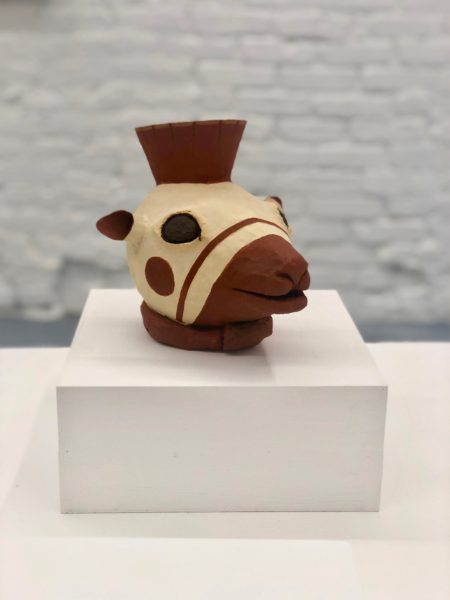
Exquisitely fashioned, the papier-mâché containers made by Irasema are beautiful and look much like artifacts from earlier history as they do deliberately resemble. This is because they are in fact copies of ceramic works held in museums today. This combination of antique effect and new design make the works remarkably attractive; they are ambitious despite their small size, and convey, by virtue of their being copied, an elegance of form and feeling we don’t often find in modern paperwork. One work, a replica of a Diaguita-Inca ceramic coming roughly from 1000 to 1500 AD, is a beautiful piece, in which a small, white rounded container, with a flat lip encircling its opening and a pair of curved attachments for holding the vessel, are decorated with small black abstract designs: dots for the container’s arms and sets of three short horizontal lines connected by very small vertical ones cover the body of the sculpture. Another replica, of a llama’s head made to be a pitcher (2019), comes from a ceramics Huari piece (800 to 1200 AD); half of the head, that is, most of the face, is given a light dun color, while the nose and mouth and short neck, along with the protuberance rising from the top of the head, are rendered in a deep, dark red. Realistic in its appearance, the llama sculpture possesses not only charm, but a historical connectedness whose energies point to an esthetic turned toward the archaic.

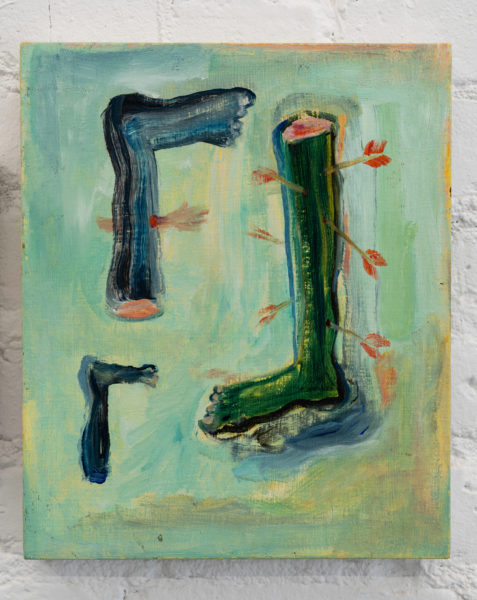
Lucía Vidales, the final artist of the group, makes paintings that combine figuration with abstract effects. They are colorful, broadly painted artworks that combine severed legs and feet and nonobjective forms that carry a strong emotional effect. In One Should Think Oneself Incomplete (2018), the viewer sees three legs, one green, and right-side up on the right, and the other two upside down and dark, dark blue on the left. The severed legs on the right have several reddish-pink arrows passing through it; the one on the upper left has a single such arrow. The background is light green with touches of blue and some vaporous white color. Perhaps Vidales’ audience might think of St. Sebastian; the title suggests the imagery is a literal illustration for its metaphorical implications. 400 Eyes (2019) is a vertically aligned painting, in which large white eyes with black pupils dot a background composed of dark blue and dark green organic shapes, which fit together roughly like a puzzle. The shapes seem to describe two figures, rather simplified, in the middle of the composition, although this may be an excessive conjecture. Both paintings deal with body parts in disturbing fashion. Like the other two artists, Vidales’ does not seem to connect in an obvious manner with the notion of dark soil, but it is clear that all three women here are offering deep-set connections between emotion and histories that have occurred in the geographical region from which they come. This may mean, then, that the art seen here does, in fact, join with the notion of soil–in a figurative sense but not a literal one. Sometimes the undercurrent of an artwork offers more than the external message. These three artists know that well.
Participating Artists: Isa Carrillo, Circe Irasema, and Lucía Vidales
Terra Preta at PROXYCO Gallery
Curated by Paulina Ascencio
PROXYCO Gallery, 168 Suffolk Street, New York, NY 10002
